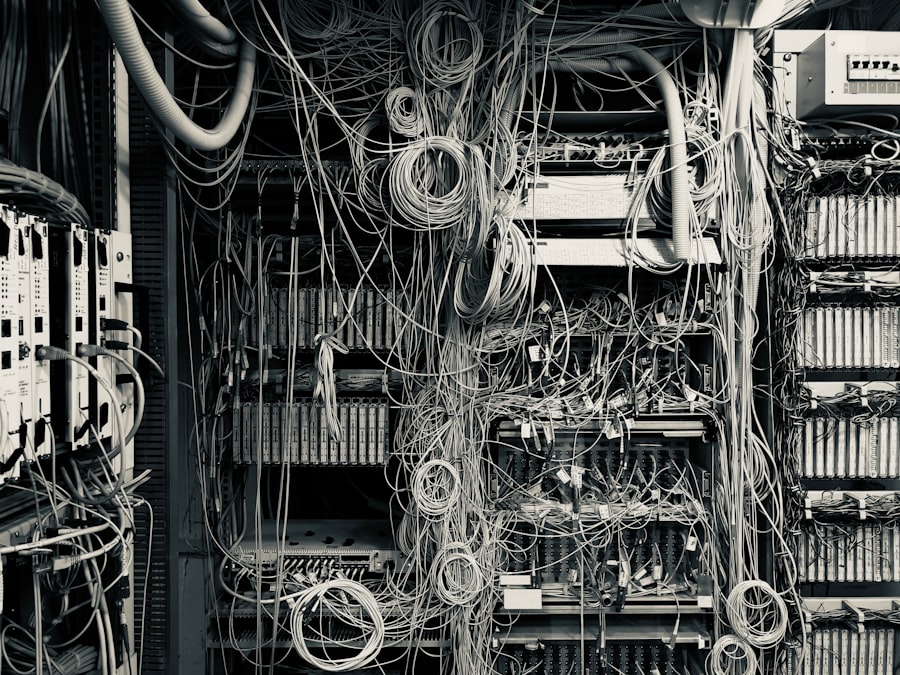Distributed systems are a collection of independent computers that appear to their users as a single coherent system. These systems are designed to work together to achieve a common goal, often sharing resources and data across multiple nodes. The architecture of distributed systems can vary widely, from simple client-server models to complex peer-to-peer networks.
The fundamental characteristic that defines a distributed system is the ability to coordinate and communicate among its components, which may be geographically dispersed. This communication is typically facilitated through a network, allowing for the seamless exchange of information and resources. The concept of distributed systems has evolved significantly over the years, driven by advancements in technology and the increasing demand for scalable and resilient computing solutions.
Early implementations were often limited by hardware constraints and network capabilities, but modern distributed systems leverage high-speed internet connections, cloud computing, and sophisticated algorithms to enhance performance and reliability. As a result, distributed systems can handle vast amounts of data and provide services to millions of users simultaneously, making them integral to the functioning of contemporary applications and services.
Key Takeaways
- Distributed systems are a network of independent computers that work together to achieve a common goal, often through sharing resources and processing tasks.
- The benefits of distributed systems include improved performance, scalability, fault tolerance, and cost-effectiveness.
- Challenges of distributed systems include complexity, security risks, data consistency, and communication overhead.
- Key components of distributed systems include nodes, communication protocols, distributed databases, and load balancing mechanisms.
- Applications of distributed systems range from cloud computing and content delivery networks to peer-to-peer file sharing and distributed databases.
Benefits of Distributed Systems
Scalability and Elasticity
One of the primary advantages of distributed systems is their ability to scale efficiently. As demand for resources increases, additional nodes can be added to the system without significant reconfiguration. This elasticity allows organizations to efficiently manage workloads and optimize resource utilization.
Fault Tolerance and Redundancy
Another significant benefit of distributed systems is fault tolerance. In a distributed system, the failure of one or more components does not necessarily lead to the failure of the entire system. Redundancy is built into the architecture, allowing other nodes to take over the responsibilities of failed components.
Real-World Applications
For instance, cloud service providers like Amazon Web Services (AWS) and Microsoft Azure enable businesses to scale their applications dynamically based on real-time usage patterns, ensuring that they only pay for what they use while maintaining high availability. In a distributed database system like Apache Cassandra, data is replicated across multiple nodes. If one node goes down, the system can still function normally by accessing data from other nodes, thereby ensuring continuous operation and minimizing downtime.
Challenges of Distributed Systems

Despite their numerous advantages, distributed systems also present several challenges that must be addressed to ensure their effectiveness. One of the most significant challenges is managing consistency across distributed components. In a distributed environment, data may be replicated across multiple nodes, leading to potential discrepancies if updates are not synchronized properly.
This issue is often referred to as the CAP theorem, which states that it is impossible for a distributed system to simultaneously provide consistency, availability, and partition tolerance. As a result, system designers must make trade-offs based on the specific requirements of their applications. Another challenge is network latency and communication overhead.
In a distributed system, components must communicate over a network, which can introduce delays that affect performance. The time taken for messages to travel between nodes can vary based on network conditions, leading to unpredictable response times. Additionally, as the number of nodes increases, the complexity of managing communication also grows. Protocols must be established to ensure reliable message delivery and error handling, which can add further complexity to the system’s design.
Key Components of Distributed Systems
| Component | Description |
|---|---|
| Communication | Allows different components to exchange data and messages. |
| Concurrency | Enables multiple tasks to execute simultaneously. |
| Scalability | Ability to handle increasing workload by adding resources. |
| Fault Tolerance | System’s ability to continue operating in the event of failure. |
| Consistency | Ensures all nodes in the system have the same data at the same time. |
Distributed systems consist of several key components that work together to facilitate communication and resource sharing. At the core are the nodes themselves, which can be physical machines or virtual instances running on cloud infrastructure. Each node typically has its own local storage and processing capabilities, allowing it to perform tasks independently while still being part of a larger system.
Communication protocols are another critical component of distributed systems. These protocols define how nodes exchange information and coordinate their actions. Common protocols include HTTP for web-based communication, gRPC for high-performance remote procedure calls, and message queuing systems like Apache Kafka for asynchronous communication.
The choice of protocol can significantly impact the performance and reliability of the system. Additionally, middleware plays a vital role in distributed systems by providing services that facilitate communication and resource management.
Applications of Distributed Systems
Distributed systems have found applications across various domains due to their ability to handle large-scale data processing and provide high availability. One prominent application is in cloud computing, where services are delivered over the internet from a network of remote servers. Companies like Google and Microsoft utilize distributed systems to power their cloud platforms, enabling users to access computing resources on demand without needing to invest in physical infrastructure.
Another significant application is in big data analytics. Distributed systems like Apache Hadoop allow organizations to process vast amounts of data across clusters of machines efficiently. By distributing data processing tasks among multiple nodes, these systems can analyze large datasets much faster than traditional single-node solutions.
This capability is crucial for businesses seeking insights from data generated by customer interactions, social media activity, or sensor readings in IoT devices. Distributed systems are also prevalent in content delivery networks (CDNs), which optimize the delivery of web content by caching it across multiple geographically dispersed servers. This approach reduces latency for end-users by serving content from a server that is closer to their location.
Companies like Akamai and Cloudflare leverage distributed systems to ensure fast and reliable content delivery for websites and applications worldwide.
The Future of Distributed Systems

The future of distributed systems is poised for significant advancements driven by emerging technologies such as edge computing, artificial intelligence (AI), and blockchain. Edge computing extends the capabilities of distributed systems by processing data closer to where it is generated rather than relying solely on centralized cloud servers. This approach reduces latency and bandwidth usage while enabling real-time processing for applications like autonomous vehicles and smart cities.
Artificial intelligence is also set to play a transformative role in distributed systems. AI algorithms can optimize resource allocation, enhance fault detection mechanisms, and improve decision-making processes within distributed environments. For instance, machine learning models can analyze patterns in network traffic to predict potential failures or security threats, allowing for proactive measures to be taken before issues arise.
Blockchain technology introduces another layer of innovation by providing decentralized trust mechanisms within distributed systems. By leveraging cryptographic techniques and consensus algorithms, blockchain enables secure transactions and data sharing among untrusted parties without relying on a central authority. This capability has implications for various industries, including finance, supply chain management, and healthcare.
Best Practices for Implementing Distributed Systems
Implementing a successful distributed system requires careful planning and adherence to best practices that address both technical and organizational challenges. One essential practice is designing for failure by incorporating redundancy and failover mechanisms into the architecture. This approach ensures that if one component fails, others can seamlessly take over its responsibilities without disrupting service.
Another best practice involves monitoring and logging system performance continuously. By collecting metrics on resource utilization, response times, and error rates, organizations can gain insights into how their distributed system operates under different conditions. This information is invaluable for identifying bottlenecks or potential points of failure before they impact users.
Additionally, adopting a microservices architecture can enhance the modularity and maintainability of distributed systems. By breaking down applications into smaller, independently deployable services, teams can develop and scale components more efficiently while minimizing interdependencies. This approach aligns well with agile development practices and allows organizations to respond quickly to changing business needs.
Case Studies of Successful Distributed Systems
One notable case study is Netflix’s use of distributed systems to deliver streaming content to millions of users worldwide. Netflix employs a microservices architecture hosted on Amazon Web Services (AWS), allowing it to scale its services dynamically based on user demand. The company utilizes various AWS services such as Elastic Load Balancing and Amazon S3 for storage while implementing sophisticated caching strategies to optimize content delivery speed.
Another example is Google’s Bigtable, a distributed storage system designed for managing structured data across large clusters of machines. Bigtable powers many Google services such as Search and Maps by providing high throughput and low latency access to massive datasets. Its architecture allows for horizontal scaling by adding more servers as needed while maintaining strong consistency guarantees.
In the realm of finance, blockchain-based platforms like Ethereum have revolutionized how transactions are conducted in a decentralized manner. Ethereum’s smart contracts enable self-executing agreements without intermediaries, fostering trust among participants in various industries such as finance, real estate, and supply chain management. The platform’s ability to support decentralized applications (dApps) has led to innovative solutions that leverage blockchain technology for transparency and security.
These case studies illustrate how organizations leverage distributed systems’ unique capabilities to address complex challenges while delivering value to their users through enhanced performance, scalability, and reliability.
If you are interested in learning more about the history of mathematics and its impact on modern technology, you may want to check out this article on the beginnings of calculus. This article discusses the contributions of Newton, Leibniz, Euler, and Gauss to the development of calculus, a branch of mathematics that is essential for understanding complex systems like distributed systems. You can read more about it here.





















+ There are no comments
Add yours